in what ways are flowers adapted to help angiosperms reproduce
Seed Plants
134 Angiosperms
Learning Objectives
By the terminate of this department, you will exist able to do the post-obit:
- Explain why angiosperms are the dominant form of plant life in virtually terrestrial ecosystems
- Describe the principal parts of a flower and their functions
- Detail the life bicycle of a typical gymnosperm and angiosperm
- Discuss the similarities and differences betwixt the two main groups of flowering plants
From their humble and even so obscure beginning during the early Jurassic period, the angiosperms—or flowering plants—have evolved to dominate most terrestrial ecosystems ((Figure)). With more than 300,000 species, the angiosperm phylum (Anthophyta) is second only to insects in terms of diversification.
Flowers. These flowers abound in a botanical garden border in Bellevue, WA. Flowering plants dominate terrestrial landscapes. The brilliant colors of flowers and enticing fragrance of flowers are adaptations to pollination by animals like insects, birds, and bats. (credit: Myriam Feldman)
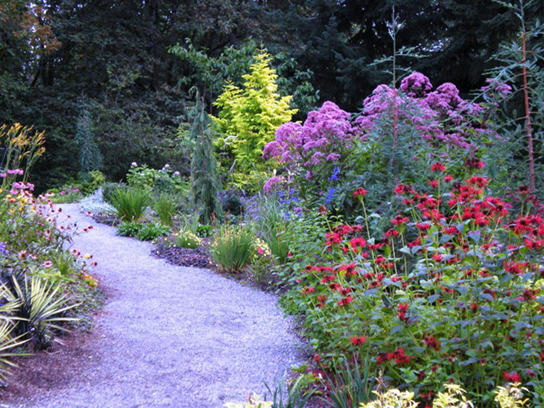
The success of angiosperms is due to 2 novel reproductive structures: flowers and fruits. The function of the flower is to ensure pollination, often past arthropods, as well every bit to protect a developing embryo. The colors and patterns on flowers offer specific signals to many pollinating insects or birds and bats that have coevolved with them. For case, some patterns are visible merely in the ultraviolet range of light, which can be seen by arthropod pollinators. For some pollinators, flowers annunciate themselves as a reliable source of nectar. Flower scent besides helps to select its pollinators. Sweet scents tend to attract bees and collywobbles and moths, but some flies and beetles might adopt scents that signal fermentation or putrefaction. Flowers also provide protection for the ovule and developing embryo inside a receptacle. The part of the fruit is seed protection and dispersal. Different fruit structures or tissues on fruit—such as sweet flesh, wings, parachutes, or spines that grab—reverberate the dispersal strategies that assist spread seeds.
Flowers
Flowers are modified leaves, or sporophylls, organized effectually a fundamental receptacle. Although they vary greatly in appearance, virtually all flowers incorporate the same structures: sepals, petals, carpels, and stamens. The peduncle typically attaches the flower to the establish proper. A whorl of sepals (collectively called the calyx) is located at the base of the peduncle and encloses the unopened floral bud. Sepals are commonly photosynthetic organs, although in that location are some exceptions. For case, the corolla in lilies and tulips consists of iii sepals and three petals that await virtually identical. Petals, collectively the corolla, are located inside the whorl of sepals and may brandish brilliant colors to attract pollinators. Sepals and petals together form the perianth. The sexual organs, the female person gynoecium and male androecium are located at the center of the blossom. Typically, the sepals, petals, and stamens are fastened to the receptacle at the base of operations of the gynoecium, just the gynoecium may also be located deeper in the receptacle, with the other floral structures fastened higher up information technology.
Equally illustrated in (Figure), the innermost part of a perfect flower is the gynoecium, the location in the flower where the eggs will form. The female person reproductive unit of measurement consists of one or more carpels, each of which has a stigma, manner, and ovary. The stigma is the location where the pollen is deposited either by wind or a pollinating arthropod. The sticky surface of the stigma traps pollen grains, and the style is a connecting structure through which the pollen tube will grow to reach the ovary. The ovary houses one or more ovules, each of which will ultimately develop into a seed. Flower structure is very diverse, and carpels may be singular, multiple, or fused. (Multiple fused carpels comprise a pistil.) The androecium, or male reproductive region is composed of multiple stamens surrounding the central carpel. Stamens are equanimous of a sparse stalk called a filament and a sac-like construction called the anther. The filament supports the anther, where the microspores are produced past meiosis and develop into haploid pollen grains, or male gametophytes.
Flower structure. This paradigm depicts the structure of a perfect flower. Perfect flowers produce both male and female floral organs. The bloom shown has simply one carpel, but some flowers accept a cluster of carpels. Together, all the carpels make upwards the gynoecium. (credit: modification of work by Mariana Ruiz Villareal)
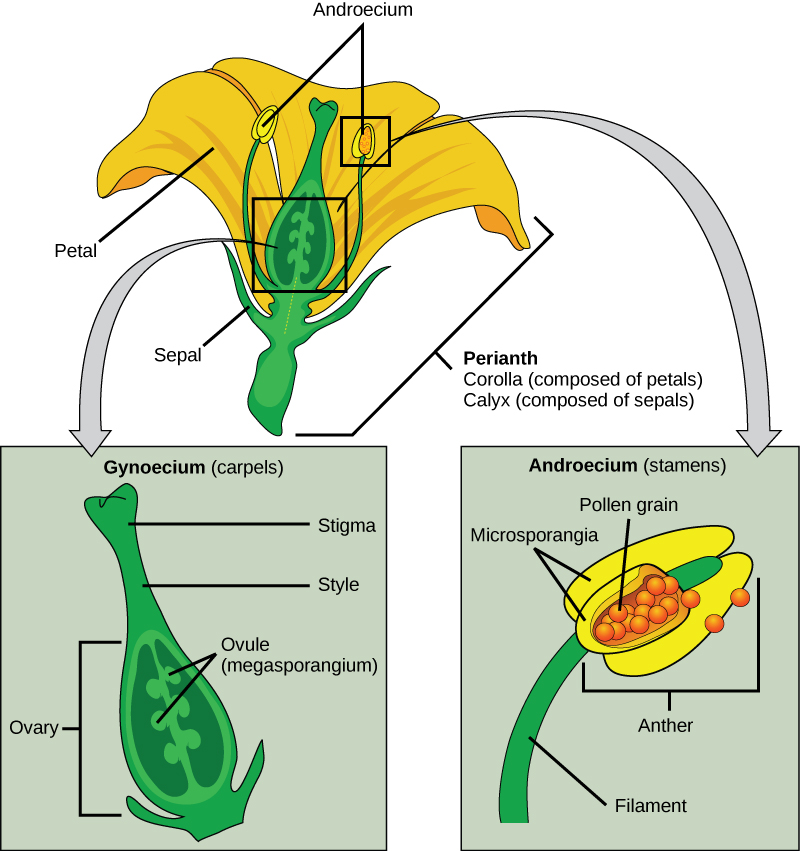
The Life Bike of an Angiosperm
The developed or sporophyte phase is the primary phase of an flowering plant's life bicycle ((Figure)). Like gymnosperms, angiosperms are heterosporous. Therefore, they produce microspores, which will generate pollen grains as the male gametophytes, and megaspores, which will grade an ovule that contains female gametophytes. Inside the anther'due south microsporangia, male person sporocytes split by meiosis to generate haploid microspores, which, in turn, undergo mitosis and give ascent to pollen grains. Each pollen grain contains two cells: one generative prison cell that will divide into two sperm and a 2d cell that volition become the pollen tube cell.
Visual Connection
Angiosperm life cycle. The life bicycle of an angiosperm is shown. Anthers and carpels are structures that shelter the actual gametophytes: the pollen grain and embryo sac. Double fertilization is a process unique to angiosperms. (credit: modification of work by Mariana Ruiz Villareal)
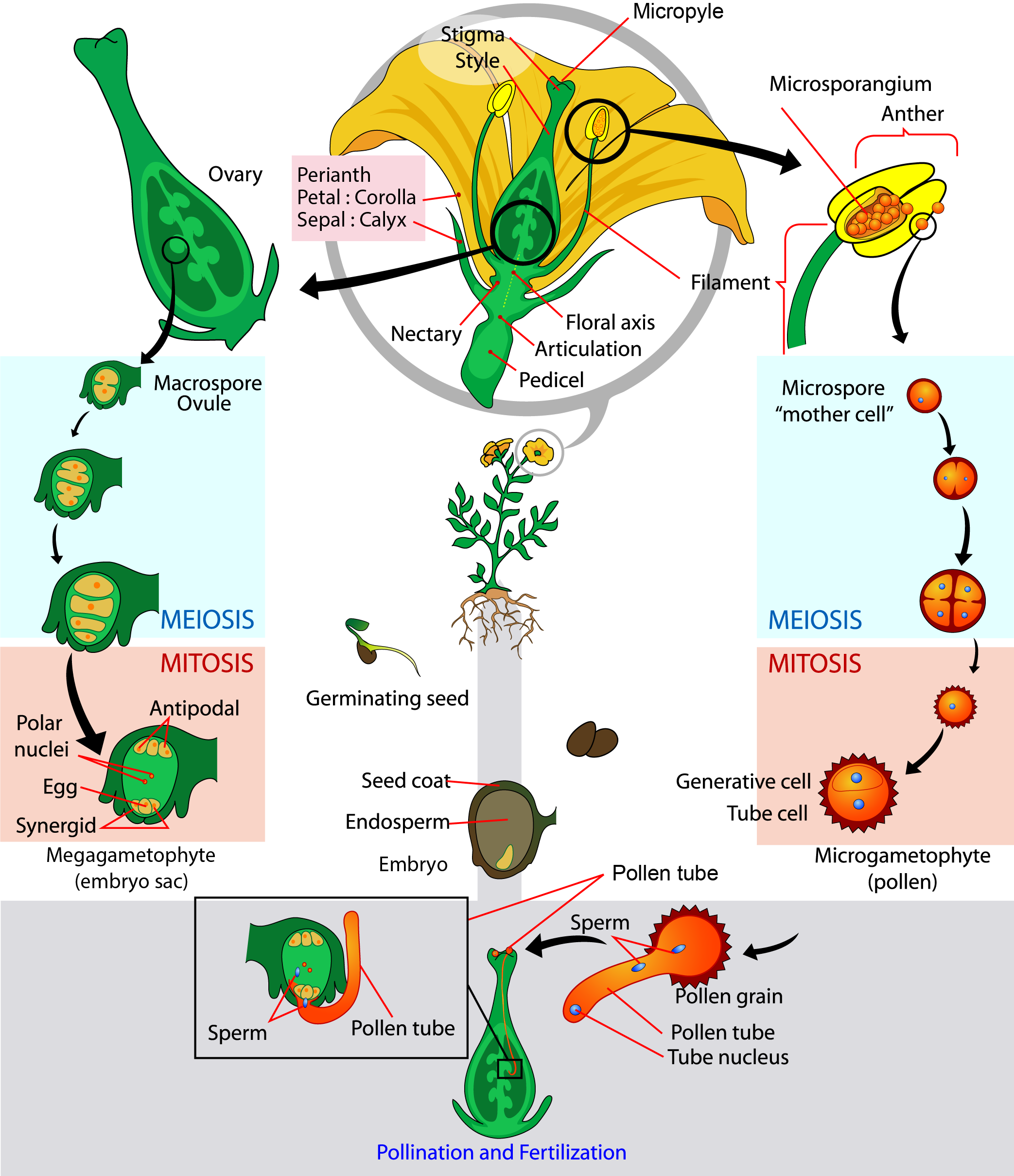
Question: If a flower lacked a megasporangium, what type of gamete would not form? If the flower lacked a microsporangium, what type of gamete would not course?
<!–<para>Without a megasporangium, an egg would non form; without a microsporangium, pollen would not form.–>
The ovule, sheltered within the ovary of the carpel, contains the megasporangium protected by two layers of integuments and the ovary wall. Within each megasporangium, a diploid megasporocyte undergoes meiosis, generating 4 haploid megaspores—three small and one big. Only the large megaspore survives; it divides mitotically three times to produce eight nuclei distributed among the seven cells of the female gametophyte or embryo sac. 3 of these cells are located at each pole of the embryo sac. The iii cells at one pole become the egg and two synergids. The 3 cells at the opposite pole become converse cells. The center jail cell contains the remaining two nuclei (polar nuclei). This cell will eventually produce the endosperm of the seed. The mature embryo sac so contains one egg cell, ii synergids or "helper" cells, three antipodal cells (which eventually degenerate), and a key cell with two polar nuclei. When a pollen grain reaches the stigma, a pollen tube extends from the grain, grows downwards the mode, and enters through the micropyle: an opening in the integuments of the ovule. The two sperm are deposited in the embryo sac.
A double fertilization effect then occurs. One sperm and the egg combine, forming a diploid zygote—the future embryo. The other sperm fuses with the polar nuclei, forming a triploid cell that will develop into the endosperm—the tissue that serves equally a food reserve for the developing embryo. The zygote develops into an embryo with a radicle, or small root, and one (monocot) or ii (dicot) leafage-similar organs called cotyledons. This difference in the number of embryonic leaves is the basis for the two major groups of angiosperms: the monocots and the eudicots. Seed food reserves are stored outside the embryo, in the course of complex carbohydrates, lipids, or proteins. The cotyledons serve every bit conduits to transmit the broken-down nutrient reserves from their storage site inside the seed to the developing embryo. The seed consists of a toughened layer of integuments forming the coat, the endosperm with food reserves, and at the center, the well-protected embryo.
Most angiosperms accept perfect flowers, which means that each blossom carries both stamens and carpels ((Figure)). In monoecious plants, male person (staminate) and female (pistillate) flowers are carve up, but carried on the same plant. Sweetgums (Liquidambar spp.) and beeches (Betula spp. are monoecious ((Figure)). In dioecious plants, male and female flowers are found on separate plants. Willows (Salix spp.) and poplars (Populus spp.) are dioecious. In spite of the predominance of perfect flowers, merely a few species of angiosperms cocky-pollinate. Both anatomical and environmental barriers promote cantankerous-pollination mediated by a physical agent (wind or water), or an animate being, such as an insect or bird. Cantankerous-pollination increases genetic diversity in a species.
Beech inflorescences. The female inflorescence is at the upper left. The male inflorescence is at the lower correct. (credit: Stephen J. Baskauf, 2002. http://bioimages.vanderbilt.edu/baskauf/10593. Morphbank :: Biological Imaging (http://www.morphbank.net/, 29 June 2017). Florida Country Academy, Section of Scientific Computing, Tallahassee, FL 32306-4026 Us)
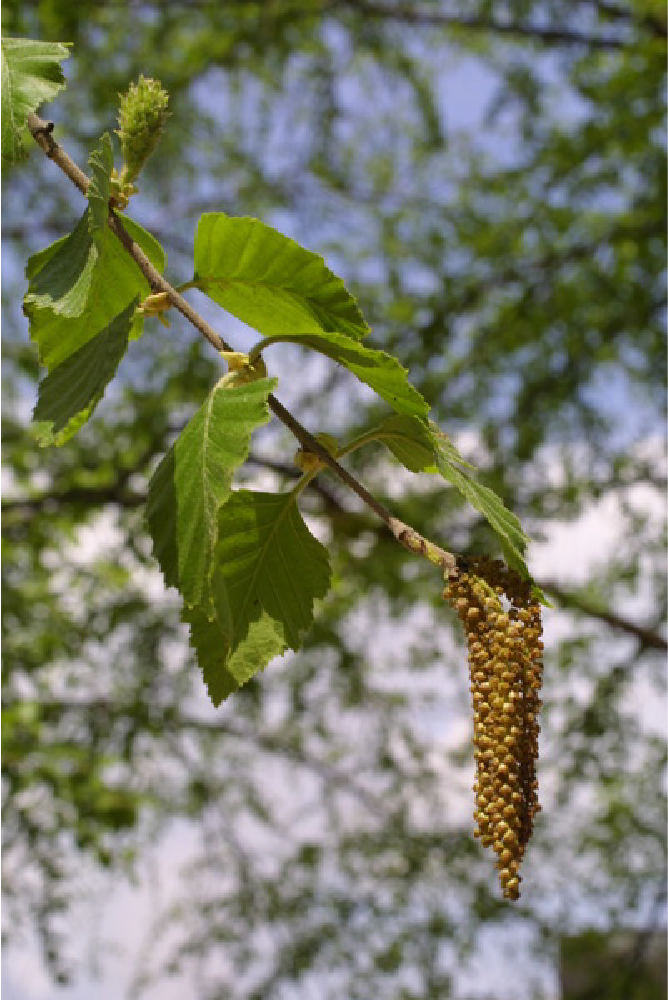
Fruit
As the seed develops, the walls of the ovary thicken and course the fruit. The seed forms in an ovary, which also enlarges as the seeds grow. Many foods commonly called vegetables are actually fruits. Eggplants, zucchini, string beans, tomatoes, and bell peppers are all technically fruits because they incorporate seeds and are derived from the thick ovary tissue. Acorns are truthful nuts, and winged maple "helicopter seeds" or whirligigs (whose botanical proper noun is samara) are as well fruits. Botanists classify fruit into more than two dozen unlike categories, only a few of which are actually fleshy and sugariness.
Mature fruit can be fleshy or dry. Fleshy fruit include the familiar berries, peaches, apples, grapes, and tomatoes. Rice, wheat, and nuts are examples of dry fruit. Another subtle distinction is that non all fruits are derived from just the ovary. For example, strawberries are derived from the ovary every bit well as the receptacle, and apples are formed from the ovary and the pericarp, or hypanthium. Some fruits are derived from divide ovaries in a unmarried flower, such as the raspberry. Other fruits, such as the pineapple, form from clusters of flowers. Additionally, some fruits, similar watermelon and orange, accept rinds. Regardless of how they are formed, fruits are an amanuensis of seed dispersal. The diverseness of shapes and characteristics reflect the manner of dispersal. Wind carries the light dry fruits of copse and dandelions. Water transports floating coconuts. Some fruits attract herbivores with their color or scent, or every bit food. Once eaten, tough, undigested seeds are dispersed through the herbivore'due south feces (endozoochory). Other fruits have burrs and hooks to cling to fur and hitch rides on animals (epizoochory).
Diversity of Angiosperms
Angiosperms are classified in a unmarried phylum: the Anthophyta. Modern angiosperms appear to exist a monophyletic grouping, which equally y'all may call back means that they originated from a single ancestor. Inside the angiosperms are three major groups: basal angiosperms, monocots, and dicots. Basal angiosperms are a group of plants that are believed to have branched off before the separation of the monocots and eudicots, because they showroom traits from both groups. They are categorized separately in most nomenclature schemes. The basal angiosperms include Amborella, water lilies, the Magnoliids (magnolia copse, laurels, and spice peppers), and a grouping called the Austrobaileyales, which includes the star anise. The monocots and dicots are differentiated on the basis of the construction of the cotyledons, pollen grains, and other structures. Monocots include grasses and lilies, and the dicots course a multi-branched group that includes (amongst many others) roses, cabbages, sunflowers, and mints.
Basal Angiosperms
The Magnoliidae are represented past the magnolias, laurels, and peppers. Magnolias are tall copse bearing dark, shiny leaves, and large, fragrant flowers with many parts, and are considered archaic ((Figure)). In the outer whorl of the magnolia flower the sepals and petals are undifferentiated and are collectively chosen tepals. The reproductive parts are bundled in a spiral effectually a cone-shaped receptacle, with the carpels located above the stamens ((Figure)). The amass fruit, with one seed formed from each carpel, is seen in (Figure)d. Laurel copse produce fragrant leaves and small-scale, camouflaged flowers. The Laurales grow mostly in warmer climates and are small-scale trees and shrubs. Familiar plants in this group include the bay laurel, cinnamon, spice bush ((Effigy)a), and avocado tree.
Magnolia grandiflora. A cluster of carpels can be seen in a higher place the stamens, which have shed their pollen and begun to drop from the inflorescence. In the flower, the sepals and petals are undifferentiated and are collectively called tepals. (credit: Ianaré Sévi. http://bioimages.vanderbilt.edu/baskauf/10949)
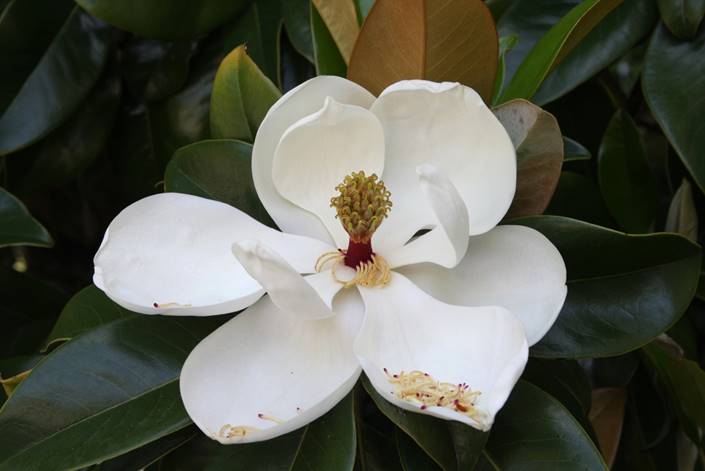
Basal angiosperms. The (a) common spicebush belongs to the Laurales, the aforementioned family as cinnamon and bay laurel. The fruit of (b) the Piper nigrum constitute is black pepper, the main production that was traded along spice routes. Notice the pocket-size, unobtrusive, clustered flowers. The leaf venation resembles that of both the monocots (parallel) and the dicots (branched). (c) Water lilies, Nymphaea lotus. Although the leaves of the plant bladder on the surface of the water, their roots are in the underlying soil at the bottom of the lake. The amass fruit of a magnolia (d). The fruit is in its terminal stage, with its scarlet seeds just starting to appear. (credit a: modification of work by Cory Zanker; credit b: modification of work by Franz Eugen Köhler; credit c: modification of piece of work by Rl/Wikimedia Commons. d: modification of work by "Coastside2″/Wikimedia Commons).
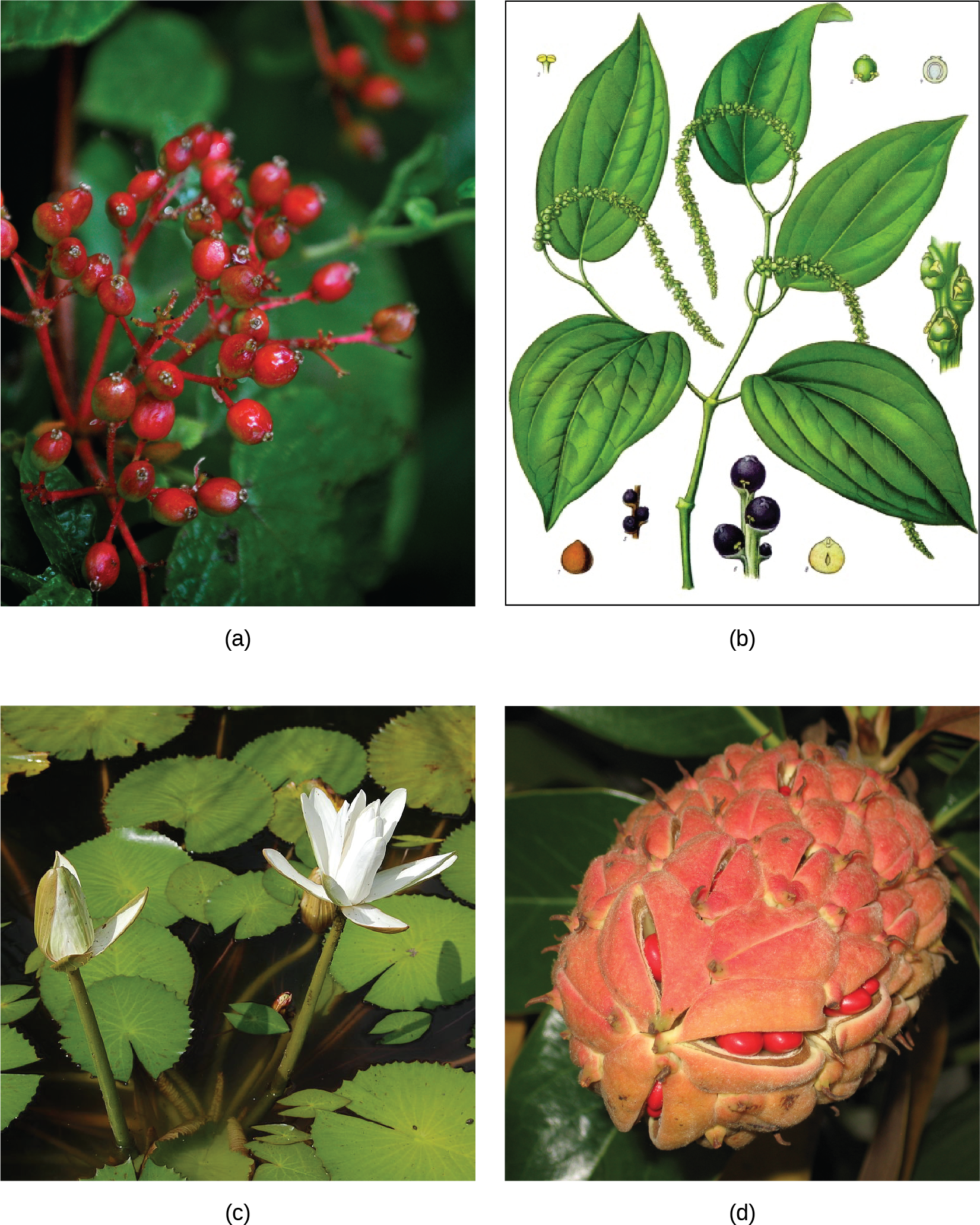
Monocots
Plants in the monocot group are primarily identified by the presence of a single cotyledon in the seedling. Other anatomical features shared past monocots include veins that run parallel to and along the length of the leaves, and flower parts that are arranged in a three- or six-fold symmetry. True woody tissue is rarely constitute in monocots. In palm trees, vascular and parenchyma tissues produced past the master and secondary thickening meristems course the torso. The pollen from the outset angiosperms was probable monosulcate, containing a unmarried furrow or pore through the outer layer. This feature is yet seen in the modern monocots. Vascular tissue of the stem is scattered, not arranged in any particular blueprint, but is organized in a ring in the roots. The root organisation consists of multiple gristly roots, with no major tap root. Adventitious roots often sally from the stem or leaves. The monocots include familiar plants such as the truthful lilies (Liliopsida), orchids, yucca, asparagus, grasses, and palms. Many important crops are monocots, such every bit rice and other cereals, corn, saccharide cane, and tropical fruits like bananas and pineapples ((Figure)a,b,c).
Monocot and dicot crop plants. The world's major crops are flowering plants. (a) Rice, (b) wheat, and (c) bananas are monocots, while (d) cabbage, (eastward) beans, and (f) peaches are dicots. (credit a: modification of piece of work by David Nance, USDA ARS; credit b, c: modification of work by Rosendahl; credit d: modification of work past Beak Tarpenning, USDA; credit e: modification of work by Scott Bauer, USDA ARS; credit f: modification of piece of work by Keith Weller, USDA)
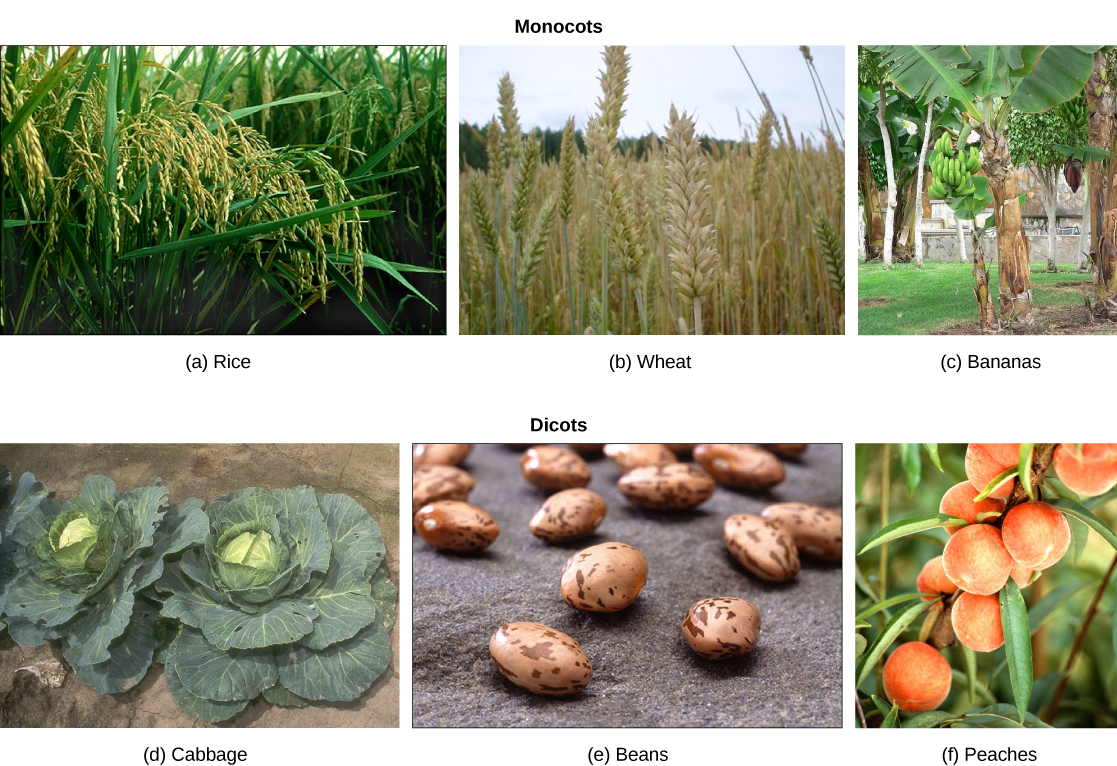
Eudicots
Eudicots, or truthful dicots, are characterized past the presence of two cotyledons in the developing shoot. Veins form a network in leaves, and bloom parts come in iv, 5, or many whorls. Vascular tissue forms a ring in the stem; in monocots, vascular tissue is scattered in the stalk. Eudicots can be herbaceous (not woody), or produce woody tissues. Near eudicots produce pollen that is trisulcate or triporate, with three furrows or pores. The root organisation is usually anchored by one principal root developed from the embryonic radicle. Eudicots comprise two-thirds of all flowering plants. The major differences between monocots and eudicots are summarized in (Effigy). However, some species may exhibit characteristics ordinarily associated with the other grouping, so identification of a plant as a monocot or a eudicot is not ever straightforward.
| Comparing of Structural Characteristics of Monocots and Eudicots | ||
|---|---|---|
| Characteristic | Monocot | Eudicot |
| Cotyledon | I | Two |
| Veins in Leaves | Parallel | Network (branched) |
| Stem Vascular Tissue | Scattered | Arranged in ring pattern |
| Roots | Network of fibrous roots | Tap root with many lateral roots |
| Pollen | Monosulcate | Trisulcate |
| Blossom Parts | Three or multiple of 3 | Iv, five, multiple of iv or v and whorls |
Section Summary
Angiosperms are the dominant form of institute life in most terrestrial ecosystems, comprising about 90 percent of all institute species. Most crops and ornamental plants are angiosperms. Their success comes from two innovative structures that protect reproduction from variability in the environs: the bloom and the fruit. Flowers were derived from modified leaves; their color and fragrance encourages species-specific pollination. The primary parts of a blossom are the sepals and petals, which protect the reproductive parts: the stamens and the carpels. The stamens produce the male gametes in pollen grains. The carpels comprise the female gametes (the eggs inside the ovules), which are within the ovary of a carpel. The walls of the ovary thicken afterward fertilization, ripening into fruit that ensures dispersal by wind, h2o, or animals.
The angiosperm life cycle is dominated by the sporophyte stage. Double fertilization is an event unique to angiosperms. One sperm in the pollen fertilizes the egg, forming a diploid zygote, while the other combines with the two polar nuclei, forming a triploid jail cell that develops into a nutrient storage tissue called the endosperm. Flowering plants are divided into 2 main groups, the monocots and eudicots, according to the number of cotyledons in the seedlings. Basal angiosperms belong to an older lineage than monocots and eudicots.
Visual Connection Questions
(Figure) If a blossom lacked a megasporangium, what type of gamete would non class? If the flower lacked a microsporangium, what type of gamete would not form?
(Effigy) Without a megasporangium, an egg would non form; without a microsporangium, pollen would not form.
Review Questions
Which of the following structures in a bloom is non directly involved in reproduction?
- the manner
- the stamen
- the sepal
- the anther
C
Pollen grains develop in which construction?
- the anther
- the stigma
- the filament
- the carpel
A
In the course of double fertilization, one sperm prison cell fuses with the egg and the 2d one fuses with ________.
- the synergids
- the polar nuclei of the center cell
- the egg every bit well
- the antipodal cells
B
Corn develops from a seedling with a unmarried cotyledon, displays parallel veins on its leaves, and produces monosulcate pollen. It is well-nigh likely:
- a gymnosperm
- a monocot
- a eudicot
- a basal angiosperm
B
Critical Thinking Questions
Some cycads are considered endangered species and their trade is severely restricted. Customs officials finish suspected smugglers who claim that the plants in their possession are palm trees, not cycads. How would a botanist distinguish between the ii types of plants?
The resemblance betwixt cycads and palm trees is only superficial. Cycads are gymnosperms and exercise not deport flowers or fruit. Cycads produce cones: large, female cones that produce naked seeds, and smaller male person cones on separate plants. Palms do non.
What are the two structures that allow angiosperms to be the ascendant form of found life in most terrestrial ecosystems?
Angiosperms are successful because of flowers and fruit. These structures protect reproduction from variability in the environment.
Glossary
- anther
- sac-similar structure at the tip of the stamen in which pollen grains are produced
- Anthophyta
- phylum to which angiosperms belong
- basal angiosperms
- a group of plants that probably branched off before the separation of monocots and eudicots
- calyx
- gyre of sepals
- carpel
- unmarried unit of the pistil
- corolla
- drove of petals
- cotyledon
- primitive foliage that develops in the zygote; monocots take one cotyledon, and dicots accept two cotyledons
- dicot
- (as well, eudicot) related group of angiosperms whose embryos possess two cotyledons
- filament
- thin stalk that links the anther to the base of the bloom
- gynoecium
- (as well, carpel) structure that constitutes the female reproductive organ
- herbaceous
- grass-similar plant noticeable by the absenteeism of woody tissue
- monocot
- related group of angiosperms that produce embryos with ane cotyledon and pollen with a single ridge
- ovary
- sleeping room that contains and protects the ovule or female megasporangium
- perianth
- part of the plant consisting of the calyx (sepals) and corolla (petals)
- petal
- modified leafage interior to the sepals; colorful petals attract animal pollinators
- pistil
- fused group of carpels
- sepal
- modified leaf that encloses the bud; outermost structure of a blossom
- stamen
- structure that contains the male reproductive organs
- stigma
- uppermost structure of the carpel where pollen is deposited
- mode
- long, thin structure that links the stigma to the ovary
Source: https://opentextbc.ca/biology2eopenstax/chapter/angiosperms/
0 Response to "in what ways are flowers adapted to help angiosperms reproduce"
Post a Comment